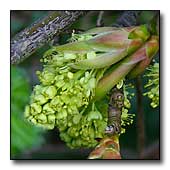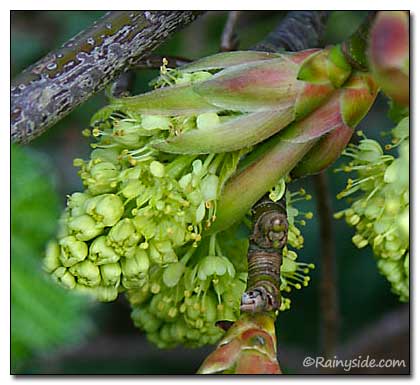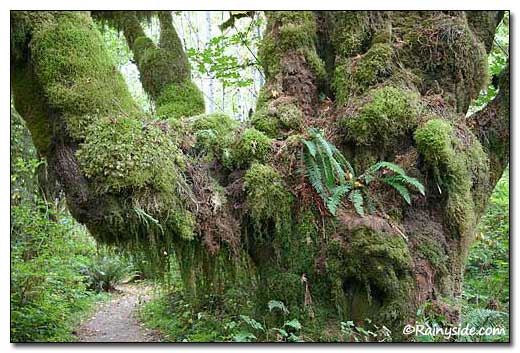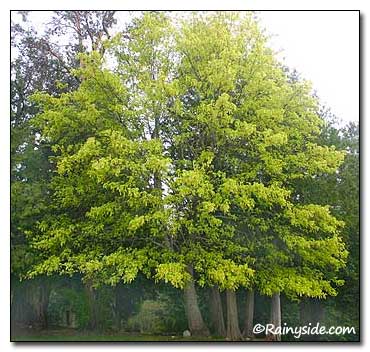Acer macrophyllum
BIG LEAF MAPLE
Family: Aceraceae
Pronounced: A-ser mak-roe-FIL-um

Quick Jumps
Growing Guide
Rainy Side Notes
GROWING GUIDE

Origin:
Pacific Northwest
Plant Group:
Trees.
Hardiness:
Sunset zones: 4-17.
USDA zones: 5-9.
Heat zones: 9-4.
Mature size:
Height:
70 feet (20 m).
Width:
70 feet (20 m).
Flowering period:
Spring.
Flowering attributes:
Yellow-green flowers on long racemes, followed by large winged fruit.
Leaf attributes:
Palmately five-lobed (sometimes three-lobed) leaf of green with pale green underside. Turns yellow and orange-brown in fall.
Light:
Full sun to partial shade.
Soil:
Moist, humus rich soil.
Propagation Methods:
Sow seed when ripe and place in cold frame.
Layering.
Pruning Methods:
Prune in late autumn to mid winter.
Rainy Side Notes

Our native, Bigleaf maple, common in the Northwest, is a large, handsome, deciduous tree. Covered with moss, they often host Polypodium glycyrrhiza (Licorice fern), which grows on their trunks. ferns In the rain forests of the Olympic Peninsula, the moss grows so thick it becomes compost, where the trees sprout roots even up in their canopies. The sap can make maple syrup, although not as well as eastern North American species. It takes three times as much sap from our native maple to make a quantity of syrup.
For many years, I was under the impression that Acer macrophyllum were not good trees to make furniture. Yet at a recycled art show, I ran my hands over an exquisite wood cabinet made from our native tree. That's one more myth laid to rest; it was beautiful wood that made an attractive piece of furniture.
Ethnobotany

Native Americans had quite a few uses for the tree. Medicinally, it was used to treat sore throats. Sprouted seeds were eaten, and some tribes rubbed the leaves on young men's faces so they would not grow thick beards. The wood was used to make paddles; leaves were used as temporary containers.
In the Garden
Familiarity normally breeds contempt, making our common native, Acer macrophyllum, a much-underrated tree in the Pacific Northwest. In the woods or a park-like setting, the maple stands regal. On a small property, this tree would overwhelm. It is not suitable as a street tree, near foundations or concrete surfaces, as its root system would destroy any surface close by. I have one growing in a wild area at the back of my property, surrounded by two hemlocks; where it is well suited.
Photographed around and about Kitsap Peninsula.

Gardening for the Homebrewer: Grow and Process Plants for Making Beer, Wine, Gruit, Cider, Perry, and More
By co-authors Debbie Teashon (Rainy Side Gardeners) and Wendy Tweton
Copyright Notice | Home | Search | Natives

